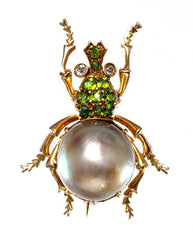History of Edwardian Insect Jewelry
 Compass Rose Design's Victorian-inspired insect jewelry is one of our most popular collections. This trend is an echo of elegant designs made more than a century ago. Throughout the Victorian era, natural themes were popular in jewelry, fashion, and furniture design. These designs embody the dynamic between the emerging industrial era and a romanticized notions of the natural world. The detailed antiqued gold and brass butterfly and honey bee buttons used in the Compass Rose Design collection are made from original antique buttons from the 1890s.
Compass Rose Design's Victorian-inspired insect jewelry is one of our most popular collections. This trend is an echo of elegant designs made more than a century ago. Throughout the Victorian era, natural themes were popular in jewelry, fashion, and furniture design. These designs embody the dynamic between the emerging industrial era and a romanticized notions of the natural world. The detailed antiqued gold and brass butterfly and honey bee buttons used in the Compass Rose Design collection are made from original antique buttons from the 1890s.
 Vever was a family-owned jewelry design house that opened in 1821 in Metz, France. They specialized in precious gem setting as well as semi-precious and organic gemstones, creating high quality art nouveau designs popular with upscale clientele. The family company won a Grand Prize for gem-set jewelery at the 1899 Paris International Exposition, and contributed to exhibitions in Moscow (1891), Chicago (1893), and Brussels (1897). The detailed construction of insects provided a perfect showcase for skilled craftsmanship.
Vever was a family-owned jewelry design house that opened in 1821 in Metz, France. They specialized in precious gem setting as well as semi-precious and organic gemstones, creating high quality art nouveau designs popular with upscale clientele. The family company won a Grand Prize for gem-set jewelery at the 1899 Paris International Exposition, and contributed to exhibitions in Moscow (1891), Chicago (1893), and Brussels (1897). The detailed construction of insects provided a perfect showcase for skilled craftsmanship.
 This 1898 late Victorian evening gown by House of Worth is made in a gorgeous silk accented with glass beads and sequins, trimmed with tulle, embroidered net in a design of butterflies applied to the skirt and bodice. The large sleeves are also typical of this period, a revival of similar 1830s balloon style sleeve, called l'imbecile (silly) or a la folle (foolish). These exaggerated sleeve styles often required small down shoulder pillows, called sleeve pumpers. From the 1840s until the brief revival in the 1890s, sleeves were more tailored.
This 1898 late Victorian evening gown by House of Worth is made in a gorgeous silk accented with glass beads and sequins, trimmed with tulle, embroidered net in a design of butterflies applied to the skirt and bodice. The large sleeves are also typical of this period, a revival of similar 1830s balloon style sleeve, called l'imbecile (silly) or a la folle (foolish). These exaggerated sleeve styles often required small down shoulder pillows, called sleeve pumpers. From the 1840s until the brief revival in the 1890s, sleeves were more tailored.
 Edwardian and Victorian jewelry designs reflected the late nineteenth-century interest and romanticized notions of the natural world. Many featured creatures including moths, butterflies, and dragonflies. This diamond, sapphire and pearl dragonfly brooch is Art Nouveau - circa 1890-1905. These woodland creepy-crawly insects provide an intriguing conceptual contrast to the tight-laced Victorian aesthetic.
Edwardian and Victorian jewelry designs reflected the late nineteenth-century interest and romanticized notions of the natural world. Many featured creatures including moths, butterflies, and dragonflies. This diamond, sapphire and pearl dragonfly brooch is Art Nouveau - circa 1890-1905. These woodland creepy-crawly insects provide an intriguing conceptual contrast to the tight-laced Victorian aesthetic.
 The late Victorian original jeweled beetle is pictured at left. The body of this elegant gold insect pin is fashioned from a magnificent pearl; the head set with green garnets; and its eyes represented by two faceted diamonds. The brooch is marked on its hook "J & M" for the firm of Jacques & Marcus, which operated in New York from about 1882 to 1892. In jewelry, as with fashion, we can see that since the founding of haute couture with the House of Worth in 1858 (ironically by an Englishman who set up shop in Paris), fashion is trend - revised, revisited, and re-envisioned.
The late Victorian original jeweled beetle is pictured at left. The body of this elegant gold insect pin is fashioned from a magnificent pearl; the head set with green garnets; and its eyes represented by two faceted diamonds. The brooch is marked on its hook "J & M" for the firm of Jacques & Marcus, which operated in New York from about 1882 to 1892. In jewelry, as with fashion, we can see that since the founding of haute couture with the House of Worth in 1858 (ironically by an Englishman who set up shop in Paris), fashion is trend - revised, revisited, and re-envisioned.
 |
 |
 |
 |
